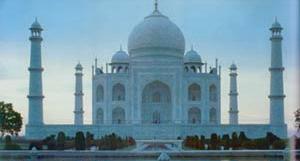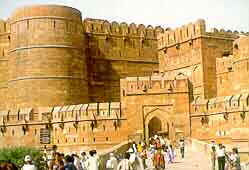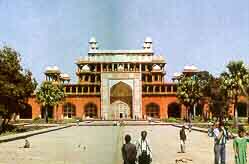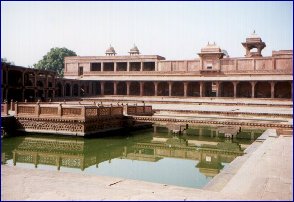 A Monument to Love
A Monument to Love
The Taj Mahal stands serene and perfect in its garden of cypresses and reflecting pools on the banks of the River Yamuna. Its pure white marble shimmers silvery white in the moonlight, glows softly pink at dawn, and at close of day reflects the fiery tints of the setting sun. The Taj in all its timeless beauty is still the inspiration of poets and painters, writers and photographers. And lovers still meet here in the moonlight in the shadow of the world's most famous monument to love.
Shahjehan built the Taj in memory of Mumtaz Mahal who died giving birth to their 14th child. No cost was spared to make it the most beautiful monument the world had ever seen. White marble and red sandstone, silver and gold, carnelian and jasper, moonstone and jade, lapis lazuli and coral were fashioned by 20,000 skilled workers to make the emperor's dream a reality. It took 22 years to complete - a symbol of eternal love where Shahjehan too lies buried, re-united at last with his beloved Mumtaz.
Set at the north end of a formal Persian garden with water courses, paved walkways and rows of dark cypresses, the Taj rises on a high red sandstone base topped by a huge white marble terrace, its flawless double dome flanked by four tapering minarets. Within lies the jewel-inlaid cenotaph of the queen, and a little to one side - the only asymmetrical feature in the Taj - the richly decorated casket of the emperor. Both are enclosed by an octagonal screen of finely pierced marble. So perfect are the proportions of the Taj, so exquisite its workmanship, that it has been described as having been designed by giants and finished by jewellers.

The Great Fort of Agra
 Built by three of the most magnificent Mughal emperors, the Agra Fort is a fitting monument to the creative and artistic genius of the times. Girdled by massive double walls and pierced by four towering gateways, the fort is a complex of palaces, courts, mosques, baths, gardens and pleasure pavilions spanning three reigns: The red sandstone Jehangiri Mahal was built by Akbar for his Hindu queen, Jodhabai, mother of Jehangir; The great Public and Private Halls of Audience: The Khas Mahal and the Palace of Mirrors;. The pure white Pearl Mosque and the jewel-like Nagina Masjid; The Garden of Grapes; The Fish Pavillion or Water Garden. Tragically, Shahjehan spent the last year of his life here as a prisoner of his own son, gazing across the river as dying at his noblest creation, the Taj Mahal.
Built by three of the most magnificent Mughal emperors, the Agra Fort is a fitting monument to the creative and artistic genius of the times. Girdled by massive double walls and pierced by four towering gateways, the fort is a complex of palaces, courts, mosques, baths, gardens and pleasure pavilions spanning three reigns: The red sandstone Jehangiri Mahal was built by Akbar for his Hindu queen, Jodhabai, mother of Jehangir; The great Public and Private Halls of Audience: The Khas Mahal and the Palace of Mirrors;. The pure white Pearl Mosque and the jewel-like Nagina Masjid; The Garden of Grapes; The Fish Pavillion or Water Garden. Tragically, Shahjehan spent the last year of his life here as a prisoner of his own son, gazing across the river as dying at his noblest creation, the Taj Mahal.
Akbar's Tomb, Sikandra
 Named after the Afghan ruler Sikander Lodi, Sikandra is better known today as the last resting place of Akbar. The emperor began to build his own garden mausoleum during his lifetime, a red sandstone monument in a chahar-bagh or 4-square formal garden. A magnificent marble-inlaid gateway leads up to the open, airy, four-tiered structure which is topped by a white marble cenotaph and screen on the fifth storey. This was added by Shahjehan who completed the mausoleum after his father's death.
Named after the Afghan ruler Sikander Lodi, Sikandra is better known today as the last resting place of Akbar. The emperor began to build his own garden mausoleum during his lifetime, a red sandstone monument in a chahar-bagh or 4-square formal garden. A magnificent marble-inlaid gateway leads up to the open, airy, four-tiered structure which is topped by a white marble cenotaph and screen on the fifth storey. This was added by Shahjehan who completed the mausoleum after his father's death.
The Tomb of Itemad-ud-Daula
It stands in the centre of a Persian garden, an architectural jewel, elegantly designed and exquisitely finished. Noorjehan, the brilliant queen of Jehangir, built it for her parents. A precursor of the Taj, this small garden tomb reflects the taste and sophistication of the gifted queen. The warm yellow marble is highlighted with white and black marble inlay. The lacey, pierced marble screens and rich, jewel-inlaid mosaics have a delicate, feminine quality that is pure enchantment.
Fatehpur Sikri
An Emperor's Dream City
 The founding of Fatehpur Sikri reads like a fairy tale. When all else had failed, the Emperor Akbar came here in search of the renowned Sufi mystic, Sheikh Salim Chishti, to ask the blessing of a son. His prayer was heard, and soon a son was born. In honour of the saint, Akbar named the new-born prince Salim and vowed to found a new city. And so Fatehpur Sikri, a magnificent new city rose on the craggy hills 40 kms from Agra. And for 16 short but memorable years it was the wonder of travellers from all over the world.
The founding of Fatehpur Sikri reads like a fairy tale. When all else had failed, the Emperor Akbar came here in search of the renowned Sufi mystic, Sheikh Salim Chishti, to ask the blessing of a son. His prayer was heard, and soon a son was born. In honour of the saint, Akbar named the new-born prince Salim and vowed to found a new city. And so Fatehpur Sikri, a magnificent new city rose on the craggy hills 40 kms from Agra. And for 16 short but memorable years it was the wonder of travellers from all over the world.
Today, Fatehpur Sikri is a deserted, phantom city. But the inner citadel is immaculately preserved. Its walls, palaces, baths, royal mint, courts and gardens still stand in splendid homage to a great visionary and builder. The heart of the palace complex however, is very much alive. For at the tomb of Sheikh Salim Chishi, a white marble canopy set in the great courtyard of the Royal Mosque, pilgrims still come in thousands to offer flowers, tie a thread in the latticed screens, and to pray for the gift of a son.
Excursions
The Bird Sanctuary of Bharatpur
An early 18th century Rajput fort 55 kms from Agra, Bharatpur is better known today for one of the finest water bird sanctuaries in the world. Called Keoladeo Ghana, the sanctuary is a 40 sq. km area of swampy, lightly wooded terrain which was once the private hunting and shooting preserve of the Maharajas of Bharatpur. Today it is the protected breeding ground of hundreds of species of birds and home of migratory birds that winter here, especially the Siberian Crane.
Pleasant accommodation is available at the Forest Lodge within the sanctuary and at several motels and hotels outside. Visitors can drive or bicycle through the sanctuary and also take a boat through the shallows for a spectacular view of the birds. The best season for bird watching is after the monsoons - from October to January.
Mathura and Brindaban - Krishna Country
Mathura, on the banks of the River Yamuna, is celebrated as the birth place of Krishna, and the groves and ghats of nearby Brindaban with its thousands of shrines and temples still echo with stories and songs that recount the exploits of this charming god.
Mathura has been a sacred pilgrimage centre through countless centuries, and the temples and shrines that line the waterfront testify to its antiquity.
The Government Museum at Mathura is a superb repository of fine sculpture, terracotta images, coins and bronze objects that date from the 5th century BC to the 12th century.
What to buy:
The craftsmen of Agra are still renowned for the exquisite marble-inlay work that has made its monuments famous. Boxes, table-tops, trays, platters and other decorative items in white or black marble with fine inlay decorations are still the best buy. Agra is also a centre for fine leather ware, carpets and gold and silver embroidery on velvet.
Agra is also known for two delicacies: delicious, sweet, translucent petha (crystallised marrow) and crisp, spicy dalmoth (lentils).
How to reach Agra:
Flights connect Agra to Delhi, Khajuraho and Varanasi. Express trains from Delhi, Bombay, Calcutta and Madras also halt at Agra. A special air conditioned luxury train, the Taj Express, commutes between Delhi and Agra. It leaves Delhi in the morning to return at night. Breakfast and meals are served in the dining car on the Express. Connecting air conditioned, de luxe and ordinary coach tours are available from the Agra Cantt raliway station. You can drive the 204 km from Delhi to Agra in air conditioned cars which can be hired in Delhi. The ITDC Kosi Restaurant and Haryana Tourism's Dabchick Tourist Complex make convenient half-way stops.
There is an excellent bus service from Delhi to Agra and back each day. During the season, ITDC and UPSTDC operate package tours from Delhi. The best time to go to Agra is during winter when the weather is pleasantly sunny.
Where to stay:
Agra has a wide range of hotels and rest houses. The luxury hotels provide air conditioned accommodation. UPSTDC's tourist complex, Taj Khema near the Taj Mahal offers accommodation in tents and deluxe rooms. There is a UPSTDC Tourist Bungalow as well. Hotels and restaurants offer both Indian, Continental and Chinese food. Mughlai cuisine is Agra's speciality. There is an ITDC restaurant near the Taj.
Tourist Office :
Agra:
191 The Mall
Agra-282 001 (U.P.)
 A Monument to Love
A Monument to Love
 Built by three of the most magnificent Mughal emperors, the Agra Fort is a fitting monument to the creative and artistic genius of the times. Girdled by massive double walls and pierced by four towering gateways, the fort is a complex of palaces, courts, mosques, baths, gardens and pleasure pavilions spanning three reigns: The red sandstone Jehangiri Mahal was built by Akbar for his Hindu queen, Jodhabai, mother of Jehangir; The great Public and Private Halls of Audience: The Khas Mahal and the Palace of Mirrors;. The pure white Pearl Mosque and the jewel-like Nagina Masjid; The Garden of Grapes; The Fish Pavillion or Water Garden. Tragically, Shahjehan spent the last year of his life here as a prisoner of his own son, gazing across the river as dying at his noblest creation, the Taj Mahal.
Built by three of the most magnificent Mughal emperors, the Agra Fort is a fitting monument to the creative and artistic genius of the times. Girdled by massive double walls and pierced by four towering gateways, the fort is a complex of palaces, courts, mosques, baths, gardens and pleasure pavilions spanning three reigns: The red sandstone Jehangiri Mahal was built by Akbar for his Hindu queen, Jodhabai, mother of Jehangir; The great Public and Private Halls of Audience: The Khas Mahal and the Palace of Mirrors;. The pure white Pearl Mosque and the jewel-like Nagina Masjid; The Garden of Grapes; The Fish Pavillion or Water Garden. Tragically, Shahjehan spent the last year of his life here as a prisoner of his own son, gazing across the river as dying at his noblest creation, the Taj Mahal.
 Named after the Afghan ruler Sikander Lodi, Sikandra is better known today as the last resting place of Akbar. The emperor began to build his own garden mausoleum during his lifetime, a red sandstone monument in a chahar-bagh or 4-square formal garden. A magnificent marble-inlaid gateway leads up to the open, airy, four-tiered structure which is topped by a white marble cenotaph and screen on the fifth storey. This was added by Shahjehan who completed the mausoleum after his father's death.
Named after the Afghan ruler Sikander Lodi, Sikandra is better known today as the last resting place of Akbar. The emperor began to build his own garden mausoleum during his lifetime, a red sandstone monument in a chahar-bagh or 4-square formal garden. A magnificent marble-inlaid gateway leads up to the open, airy, four-tiered structure which is topped by a white marble cenotaph and screen on the fifth storey. This was added by Shahjehan who completed the mausoleum after his father's death.
 The founding of Fatehpur Sikri reads like a fairy tale. When all else had failed, the Emperor Akbar came here in search of the renowned Sufi mystic, Sheikh Salim Chishti, to ask the blessing of a son. His prayer was heard, and soon a son was born. In honour of the saint, Akbar named the new-born prince Salim and vowed to found a new city. And so Fatehpur Sikri, a magnificent new city rose on the craggy hills 40 kms from Agra. And for 16 short but memorable years it was the wonder of travellers from all over the world.
The founding of Fatehpur Sikri reads like a fairy tale. When all else had failed, the Emperor Akbar came here in search of the renowned Sufi mystic, Sheikh Salim Chishti, to ask the blessing of a son. His prayer was heard, and soon a son was born. In honour of the saint, Akbar named the new-born prince Salim and vowed to found a new city. And so Fatehpur Sikri, a magnificent new city rose on the craggy hills 40 kms from Agra. And for 16 short but memorable years it was the wonder of travellers from all over the world.